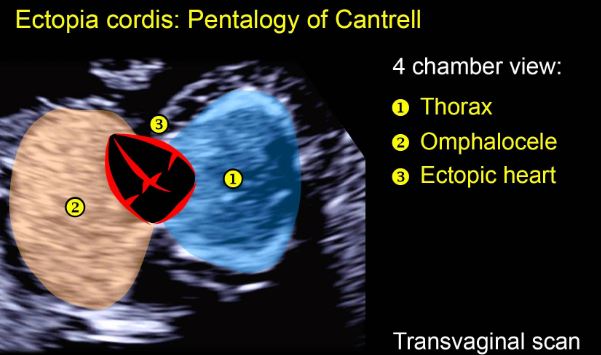Pentalogy of Cantrell
What is Pentalogy of Cantrell?
Pentalogy of Cantrell is a rarely develop congenital disorder. A combinations of organs deformity due to inherent reason are the characteristics of the Pentalogy of Cantrell. The organ defects are involved sternum or breastbone, diaphragm (the borderline present between the chest cavity and abdominal cavity), pericardium (the outer covering of the heart), the muscular membrane of the abdomen and heart.

The potential fatal complications are associated with Pentalogy of Cantrell. If all these five defective regions are potentially involved at the time of birth, then it is called complete Pentalogy of Cantrell. But some neonates may not have all the deformities and termed this condition is partial Pentalogy of Cantrell. The complications for partial Pentalogy of Cantrell is varying with organ involvement.(1)
Signs & Symptoms
The symptoms of the pentalogy of Cantrell vary from individual to individual depending upon the associated defects. In case of partial Pentalogy of Cantrell, some neonates may not have potential life threatening conditions, as minor defects associated, whereas another neonates may battle with life due to major organ involvement.
All the associated symptoms are discussed below may not develop in the neonates due to partial Pentalogy of Cantrell. Before initiating the treatment, it is necessary to discuss the observed symptoms with the pediatrician.
Ectopia cordis
Ectopia cordis is the condition in which partial or complete displacement of the heart from the chest cavity and thus cannot get protection from thoracic wall. This sign is a common, but not always related with Pentalogy of Cantrell.

Omphalocele
Omphalocele is the displacement of the intestine or other abdominal organ and projected out through the abdominal wall. In healthy, normal individual, all the abdominal organs including intestine is covered by a sac like thin membrane. Due to size variation of the membrane, the abdominal organs are projected out.
Diastasis and gastroschisis
In some cases, omphalocele may not present, but the parting of abdominal muscle (diastasis) can develop and which may associated with projections of intestine through either side of the defective umbilical cord (gastroschisis).
Defective sternum
A range of variability is associated with defective sternum, which include the absence of entire cartilage that present at the xiphoid (terminal region of the sternum). Some of the cases may associated with an abnormal small size of the sternum or fissure present at the bone structure.
Defective pericardium
A hole may develop in the pericardium at the junction of the heart and diaphragm.
Congenital diaphragmatic hernia
This condition is described as presence of puncture in the diaphragm, and through which abdominal content is projected to the chest cavity.
Cardiac deformity
Variety of cardiac deformities are associated with pentalogy of Cantrell. (i) Ventricular septal defects in which hole presents between the ventricles, the lower chamber of the heart. (ii) Atrial septal defects, a hole present between the atria, the upper chambers of the heart. (iii) Dextrocardia, defective location of the heart and placed it on the right side of the thoracic cavity instead of the left. (iv) Tetralogy of Fallot, an abnormal state in which collective defects develop in the four anatomical regions of the heart. Embolism may arise with cardiac defects and normal functioning of the heart become damaged.
Breathing difficulty
This symptom arises due to the immature development of the lungs.
Other than these, defective formation of the kidney, cleft lip, cleft palate, defective limb structure, cystic hygroma means a fluid-filled mass or sac in the head or neck area and neural tube defects (congenital defects of the CNS). (2)
Causes
The idiopathic reasons, which are intermittent in nature has linked with pentalogy of Cantrell. It is recommended that abnormal development of the midline embryonic tissue in the period between fourteen to eighteen days after conception has initiated the symptoms of pentalogy of Cantrell. Case report analysis suggests that genetic defects may have a role in the progression of this disorder. (2,3)
Diagnosis
Diagnosis of pentalogy of Cantrell is feasible by conducting antenatal sonography in the first trimester after conception.
If any detection becomes positive towards pentalogy of Cantrell during early an anatomic assessment, then it is crucial to inform parents and need detail counseling and decision making in the result of pregnancy.
To detail knowledge and detection of the multiple malformations need antenatal ultrasound, echocardiography, and magnetic resonance imaging.(3,4,5)
Treatment
Symptomatic treatment can be applied to relieve discomfort of the affected infant.
- If necessary, invasive surgical involvement requires for correction of dislocation of heart, or other cardiac, diaphragmatic and associated defects.
- A combination of surgery need to conduct for cardiac and hemodynamic changes.
- Palliative care usually recommended for infants. (2,3,5)
Prognosis
The poor prognosis is estimated with pentalogy of Cantrell. The child survival rate is low and reasons of early death include heart abnormality, hypotension, cardiac failure.(3,5)
References
1. WebMD Medical Reference from the National Organization for Rare Disorders (2015), Pentalogy of Cantrell; Retrieve from: http://www.webmd.com/children/pentalogy-of-cantrell
2. T. Andrew Burrow (2014), Pentalogy of Cantrell; National Organization for Rare Disorders; Retrieve from: http://rarediseases.org/rare-diseases/pentalogy-of-cantrell/
3. Dr Suresh CHANDRAN (2015), Pentalogy of Cantrell; Retrieve from: http://www.orpha.net/consor/cgi-bin/OC_Exp.php?Lng=GB&Expert=1335
4. Zhan Gao,Qun-Jun Duan, Ze-Wei Zhang, Li-Yang Ying, Liang-long Ma, Pentalogy of Cantrell Associated With Thoracoabdominal Ectopia Cordis; Retrieve from: http://circ.ahajournals.org/content/119/15/e483.long
5. Suresh Chandran and Dinesh Ari (2013); Pentalogy of Cantrell: An Extremely Rare Congenital Anomaly; J Clin Neonatol. 2013 Apr-Jun; 2(2): 95–97; Retrieve from: http://www.ncbi.nlm.nih.gov/pmc/articles/PMC3775145/
